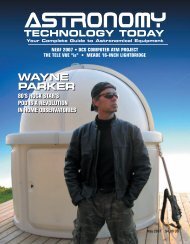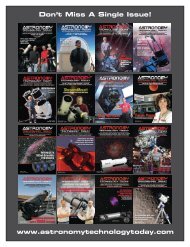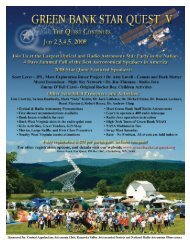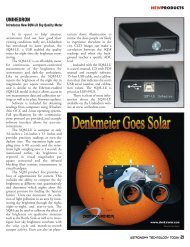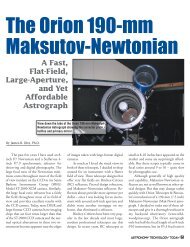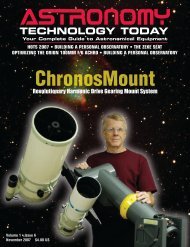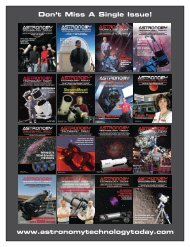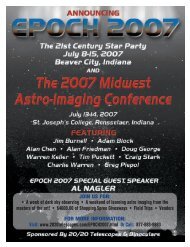Optical Mechanics Cover Article.qxd:Layout 1 - Astronomy ...
Optical Mechanics Cover Article.qxd:Layout 1 - Astronomy ...
Optical Mechanics Cover Article.qxd:Layout 1 - Astronomy ...
Create successful ePaper yourself
Turn your PDF publications into a flip-book with our unique Google optimized e-Paper software.
The “Barbarella”48-Inch DobsonianHow <strong>Optical</strong> <strong>Mechanics</strong> Builta Texas Size Dob!By James MulherinIn June of 2007, <strong>Optical</strong> <strong>Mechanics</strong>, Inc.(OMI) started a project to design and build a48-inch Dobsonian telescope for Jimi Lowreyof Ft. Davis, Texas. Having completed the telescopein April 2008, my wife Stasi and I embarkedon the trip to install Jimi’s scope. Weleft Iowa City on Saturday morning, April 11,with a loaded 29-foot U-Haul, car in tow forthe return trip. After something over 1,300miles, we pulled in to Ft. Davis at 7 p.m. Sundayevening, just in time for dinner with Jimiand some of his friends at the Limpia Hotel.The drive down was very smooth, but Stasi andI were relieved to have safely arrived with thescope at its final destination.I first met Jimi Lowrey at the 2005 Okie-Tex Star Party. We hit it off right away andspent a good bit of time observing or shootingthe breeze over morning coffee outside hismotor home parked on “Obsession Row” (Jimiwas there with his 25-inch Obsession, I withmy 15-inch, and there were many other Obsessionowners). Jimi retired a few years ago tothe Ft. Davis, Texas, area just down the hillfrom MacDonald Observatory. The area isknown for pristine skies that offer excellenttransparency for deep sky observing. Duringone conversation, Jimi told me about his ongoingproject to build a 48-inch telescope andobservatory on his property there. The observatorysite is on the side of a mountain with asouth-facing view, yet very good access to thenorthern sky. The project was in the works forabout a year already, so I assumed OMI hadmissed the boat on this one.I met Jimi again at the May 2007 TexasStar Party. At that time, the primary mirror wascoming along on schedule, but the telescopeconstruction had not yet begun. It took meabout two seconds to decide that OMI shouldoffer to build the scope. At OMI, we have experiencebuilding telescopes around large,heavy mirrors, so this project was right up ouralley. Our large telescope experience is primarilywith complex observatory-class, equatorialfork-mounted Cassegrain scopes. The Dobsoniandesign, on the other hand, is just aboutas simple a telescope as you can build, so Jimi’sproject would be refreshing departure fromwhat we normally do. And, the thought ofbuilding such a large scope, primarily for visualobservation, really appealed to the amateur astronomerin all of us at OMI. We had an openingin our production schedule and could startthe project right away, so it didn’t take me longto talk Jimi into giving us the job. We startedthe design work in June 2007, with Dave Pasleyat the helm of the design team.The design goals were set out as follows:This would be a purely visual telescope, a Dobsonianwith modern amenities such as ArgoNavis and ServoCAT for go-to and tracking. Itwould include other niceties like a FeatherTouch focuser, Telrad, a Howie Glatter laserpointer, Losmandy mounting rings for a 4-inchrefractor, a Kendrick dew heater system and alight shroud. In essence, the scope was to bejust like any other big Dob you might find onthe observing field at a star party, excepthuge… and not portable. Despite its size, asequipped, most large-Dob users would feelright at home with the 48-inch scope. Finally,the telescope would be housed in a 32- x 32-foot roll-off roof observatory on the side of themountain above Jimi’s house.Designing andConstructing the BeastSo, how does one go about designing sucha beast? You start with the primary mirror andeverything flows from there. The whole of thestructure is there to gently, but securely, holdthe primary and secondary mirror in alignmentas the scope points and tracks.The primary mirror was supplied by YuriPetrunin of Telescope Engineering Companyin Golden Colorado. It was made from a soliddisk of the ultra-low expansion glass ceramic,Astro-Sitall, by LOMO in Russia. The mirroris 48.9 inches in diameter, 4.8 inches thick andit has 28 light-weighting holes cored in its back,yet it still weighs in at a hefty 715 pounds. Aftersome consultation with Yuri Petrunin, we settledon a 36-point system for back support anda cable sling for edge support. Image 1 (page36) is a photo of the back of the mirror show-<strong>Astronomy</strong> TECHNOLOGY TODAY 31
THE “BARBARELLA” 48-INCH DOBSONIANing the cores and 36 aluminum pucks bondedto the back of the mirror. Each of these pucksprovides a hard contact point for a transferbearing on each apex of the mirror support triangles.The transfer bearings allow for differentialexpansion between the metal of the cellstructure and the zero expansion Astro-Sitallwithout stressing the mirror.The weight of the primary mirror alongthe optical axis is transferred to three definingpoints on the main cell structure that flowthrough to three primary mirror collimationbolts. The main cell consists of a W-shaped internalI-beam structure sandwiched between atop and bottom plate of 1/4-inch thick steel asdepicted in Images 4-7 (pages 36-37). Thisstructure also transfers the load of the cell andmirror into the telescopes side bearings, so itwas designed to be very stiff. For primary mirroredge support, we used an adjustable dualsling consisting of 1/4-inch diameter Nyloncoatedstainless steel cable. The attachmentpoints for the sling are on the inside wall of eachaltitude bearing.Get YoursToday!The altitude bearings were machined fromsolid 2-inch thick aluminum plate on ourCNC milling machine, which operation isshown in Image 8 (page 37). This machine cancut a 4-foot by 12-foot plate into parts and itwas fairly well maxed out in the short dimensionmaking the side bearings. The bearing arcsare machined on an 80-inch diameter center!The altitude bearings are lined with stainlesssteel straps that rest on four stainless steelrollers in the rocker box. The two front rollersare coupled by a stainless steel shaft that isdriven by the altitude servo motor. Couplingthe drive rollers together with the shaft appliesdrive torque evenly to both altitude bearings.We added hard stops to the altitude bearingsthat prevent pointing the telescope below thehorizon or beyond the zenith. The hard stopsare curved to match rollers on the rocker boxwhen the stop is reached.The rocker box is a mild steel weldmentfor rigidity. The steel plate is one inch thick. Inthe center of the box is the top half of a taperedroller bearing that carries most of the load ofLet us custom build youthe best, strongest, mostwell constructed scopetransport case available!www.scopeguard.comthe telescope and rocker box. The load is transferredthrough this bearing into the roundground plate which contains the other half ofthe tapered roller bearing mounted to a steelstub. Near the outer edge, on the top side ofthe round ground plate there are three outriggerbearings positioned 120 degrees apart.These outriggers take up a small portion of theload of the telescope, but their primary purposeit to provide a large, stabile footprint for therocker box to turn on. The outrigger bearingsrun on an annular track of flat stainless steelthat is attached to the bottom of the rocker box.Image 12 (page 37) shows the electrical contactrings. Power comes in under the ground plateand is passed via the rings and contacts to apower bus bar on the top side of the rocker box.Pointing and tracking are provided byGary Meyers at RXDesign. We used componentsfrom Gary’s standard ServoCAT systemwith some custom made components to interfacethe ServoCAT drives to our altitude rollersand azimuth friction drive system. Gary helpedus choose larger servo motors and gear reducersets to create a ServoCAT on steroids to provideincredibly accurate pointing and smoothtracking for the 5,000 pound telescope. Digitaltelescope control is provided by Wild CardInnovations’ Argo Navis which Jimi, with thehelp of Jim Chandler, has interfaced via wirelessPC serial link to the Megastar V catalog.The 48.9-inch mirror is F/4, resulting inan optical tube assembly length of about 20feet. Because of the length of the OTA, wechose a two-stage truss design as depicted inImage 18 (page 38). The truss consists of two8-truss sections connected in the middle by a 4-truss waist. The resulting truss assembly is very32 <strong>Astronomy</strong> TECHNOLOGY TODAY
THE “BARBARELLA” 48-INCH DOBSONIANstiff - the scope holds collimation very wellwhen slewing from horizon to the zenith. Infact, the stiffness of the telescope, combinedwith very smooth bearings, has resulted in ascope that is very smooth and easy to move.You can track an object at high power by pushingthe scope manually, even near Dobson’shole (near the zenith).The secondary cage is of fairly standarddesign with some features added to accommodatecounter-weights and a 4-inchrefractor. It is constructed from two aluminumrings connected by aluminum C-channel. Theinside of the secondary cage is lined withKydex. The secondary mirror is an 8-inchminor axis elliptical made for us by HowardJohnson <strong>Optical</strong> labs from a piece of fusedquartz supplied by Yuri Petrunin.After completion of the first full assemblywith the Argo and ServoCAT installed, we wereready to do some preliminary testing on thesky. The views from our shop in Iowa Cityaren’t much to brag about. On the night wetested we had only a short window of clear skyat the beginning of the night. During this timeof year (March) in Iowa we can go for weekswith no clear skies and our delivery date wasfast approaching, so we took advantage of whatlittle clear sky we had.The optics performed very well throughessentially horrible seeing conditions and evenworse light pollution. The light pollution wascompounded by the lack of a shroud at thetime of testing. All we cared about for this testwas pointing, tracking and what little we couldtell about the optics. A more rigorous test ofthe mirrors would have to wait until after weinstalled the scope in Texas. Under less thanideal conditions at our shop, fainter stars focusedto nice pin-points, but brighter starsboiled quite a bit. Of course, the primary hadvery little time to cool, so mirror currents werea significant factor.Pointing and tracking were very good.Even on large slews, for example from Polaris toRigel, the scope nailed it. We let the scope trackon M42 (the Orion nebula) for 20 minutesand detected only a small drift. Pointing andtracking would only improve after careful setup in Texas. On the whole, the telescope performedvery well. We had a little more cosmeticwork to do (light shroud, some anodizing andpowder coating, etc.), but were otherwise readyfor delivery.We hired Dave Long Protective Products,a local canvas and awning specialty shop, to designand sew the light shroud. The material isa water proof, light-tight Nylon. The shroud,shown in Image 21 (page 38), is a complex,but impressively well tailored, bit of sewing.With the completion of the shroud andsome other detail work, we were ready for delivery.We loaded the scope and left Iowa Cityon Saturday morning, April 11, arriving in Ft.Davis the following Sunday evening. After agood night’s rest we reported for work at Jimi’splace first thing Monday morning. The planwas to get started at 9 a.m., which we did. Thescope was off-loaded from the U-haul onto aflatbed truck using a construction site forklift.While we unloaded the scope, Jimi and hiscrew drove a crane truck up to the observatoryand positioned it to off-load the scope partsfrom the flatbed truck into the observatory. Theobservatory is located up the mountain fromJimi’s house. There are a couple of switch backson the road up to the house then one lastswitch back and a couple hundred yards up a20% grade to the observatory. If you didn’tknow better, you would have sworn there wasno way either of the trucks would make it upthat last dusty, rocky bit to the observatory, but,thanks to some skilled driving, the trucks wentright up.At the top there was just enough room toposition both the crane and flatbed truck toswing the crane boom over the pick points andthe center of the observatory. I stood inside theobservatory and directed Jimi, who stood in theopen door and directed the crane operator. Weflew each part into the observatory for assembly:first the ground plate, then the rocker box,side bearings and cell, primary mirror, and, finally,the upper cage and truss assembly. Wecompleted this part of the installation by lunchtime!By dinner we had completed the wiringand the rest of the fiddly bits. We had first lightthat evening. Before the installation trip, I toldJimi we’d have the scope on the sky the sameday we did the installation. Jimi thought I wasnuts. When you see the photos you’ll see why.But, I’ve done this before and it’s quite impressivewhat you can do with the right equipment.That night, as soon as we could see Polaris, wedid a star alignment, looked at a few bright objectsunder a moon that was just a few daysfrom full, then called it a night. It was a longday and I was worn out, but very pleased withthe whole operation and everyone involved. Itwas a good day.The observatory turned out to be a beautifulpiece of construction. The roof rolls off toContinued on page 40<strong>Astronomy</strong> TECHNOLOGY TODAY 33
THE “BARBARELLA” 48-INCH DOBSONIANDesign and Construction of the 48-Inch DobImage 1: The back of the primary showing the core holes.Image 4: Toney Mulherin shows off the internal structure of the primarymirror cell support.Image 2: Diagram of the 36-point support structure.Image 5: The main load-bearing cell structure and Altitude bearings.Image 3: Primary mirror support triangles with transfer bearings.Image 6: The 36 point cell attached to the cell support structure.34 <strong>Astronomy</strong> TECHNOLOGY TODAY
THE “BARBARELLA” 48-INCH DOBSONIANImage 10: The rocker box with roller bearings. Note the shaft thatcouples the two front bearings.Image 7: The primary mirror is its cell.Image 8: Machining an Altitude bearing on the CNC mill.Image 11: The bottom of the rocker box showing the stainless steeltrack for the outrigger bearings.Image 9: Altitude bearing lined with stainless steel strap, held inplace by hard stops.Image 12: The ground plate with center bearing, outrigger bearingsand electrical contact ring.<strong>Astronomy</strong> TECHNOLOGY TODAY 35
THE “BARBARELLA” 48-INCH DOBSONIANImage 13: The Azimuth drive assembly inside the rocker box.Image 16: The Altitude encoders.Image 17: The Azimuth encoders.Image 14: The Azimuth drive assembly from below where thedrive roller presses against the drive edge of the 48 inch diameterground plate.Image 15: The Altitude drive motor and gear box couples to the frontdrive roller and shaft assembly.Image 18: Dave Pasley standing next to his engineering creation.36 <strong>Astronomy</strong> TECHNOLOGY TODAY
THE “BARBARELLA” 48-INCH DOBSONIANImage 19: The business end of the telescope.Image 22: The view up the hill to Jimi’s house and observatory(roof closed).Image 15: The completed scope set up for preliminary tests in theparking lot at OMI headquarters.Image 23: James Mulherin, reporting for work Monday morningImage 21: Test fitting the shroud before delivery.Image 24: Loading the flatbed.<strong>Astronomy</strong> TECHNOLOGY TODAY 37
THE “BARBARELLA” 48-INCH DOBSONIANImage 25: The entire telescope loaded on the flatbed truck.Image 28: Setting the rocker box on the ground plateImage 26: A very nervous drive up the 20% grade to the observatory.Image 29: Lowering the Altitude and mirror cell onto the rocker box.Image 27: Craning the ground plate into the observatory.Image 30: Lowering the primary mirror into its cell.38 <strong>Astronomy</strong> TECHNOLOGY TODAY
THE “BARBARELLA” 48-INCH DOBSONIANImage 31: Installing the primary mirror.Image 32: Attaching the trusses and secondary cage.Image 33: Preparing for first light.Image 34: Van Robinson and Jimi Lowrey with a poster of the telescopes namesake: Barbarella<strong>Astronomy</strong> TECHNOLOGY TODAY 39
THE “BARBARELLA” 48-INCH DOBSONIANFollowing is a sampling fromJimi’s observing log from thenew moon period4/22/08 - Seeing: 6/10, Transparency: 8/10M42 Orion Nebula (188X, 26-mm Nagler):Pink and green and a hint of light blue colorall throughout the nebula, “E” and “F” starseasy!NGC 2392 Eskimo Nebula (390X, 12.5-mmTAK): Outer ring of pink, inner ring of greencolor. Filaments visible in outer ring of nebula.You can easily see the fur on his parka.4/24/08 - Seeing: 7/10, Transparency: 9/10NGC3242 Ghost of Jupiter (976X, 5-mmTMB Supermono): Unbelievably steady seeingat the moment. The ghost is unbelievable;pink ring on outer edge, blues and greens inthe inner rings. Looks like a Hubble picture.ScopeBuggyMAKING VIEWING EASIER!• For use with most tripods, DOBs and piers• Load tested to 600+ pounds• Assemble in minutes for use or storage• Pneumatic inflated 10” tires for soft ride• Gloss Black powder coat paint• Optional battery equipment tray• Adjustable rear axle height, 1 1/2” to 7”• Anodized gold wheels• One person can move any size scopequickly and easily• Ideal for the new Meade RCX Series• Ideal for the Meade LightBridge Series• Ideal for scopes up to 36”SCOPEBUGGYP. O. Box 834Elephant Butte, NM 87935Toll Free: 866-312-8449Plus S&H, Approx.$30 Shipping USAShipping weight 36 lbs.shipped UPS groundPatent PendingPlease visit us atwww.scopebuggy.comWE ACCEPT: VISA – MASTERCARD – AMERICAN EXPRESSPAYPAL – MONEY ORDERS – CASHIERS CHECKSHickson 50 Compact Galaxy Group, 488X,TMB Supermono): This is the dimmest of allthe Hickson group. They range from mag19.5 to 20. There are 5 members in the group,all seen with direct vision (WOW!). The fivegalaxies also seen with direct vision by VanRobinson to confirm the observation.Shakbazian 1 Galaxy group (488X, TMB Supermono):There are 17 member galaxies inthis group. Magnitude unknown (Believe youme, it’s dim.) Some members were direct vision.Others were popping in and out with theseeing. I cannot describe this effect in writing.It is beyond description. This observation wasalso confirmed by Van Robinson.Hoag’s Object (390X, 12.5-mm TAK): Thisis the famous ring galaxy in Serpens. I know ofvery few observations of the ring itself. On anight of not-so-good seeing (5/10) it was questionableif it would be visible. The core of thegalaxy was easily visible with direct vision. Ispent a lot of time looking in the eyepiece andat the first moment of good seeing the ring appeared.The size of it really startled me. I wasnot expecting it to be that big. The ring appeared4 times at moments of good seeing. Ican’t wait to try this object again at a night ofgood seeing. I think it will be visible with directvision. This observation was confirmed byJim Chandler who saw the ring appear onetime.40 <strong>Astronomy</strong> TECHNOLOGY TODAY
THE “BARBARELLA” 48-INCH DOBSONIANContinued from page 33the north to expose the entire 32- x 32-foot interiorof the building and allow access to thenorthern sky. The upper 4-foot section of thesouth wall of the building folds down to provideaccess all the way to the southern horizon.The roof and southern wall are actuated byelectric motors. There is an isolated pier in thecenter of the observatory with its foundationin bed rock. In all, the observatory is a very wellengineered and impressively stout structure.Jimi and his good friend, Van, went up tothe observatory at 3 a.m. that morning and observedthe moon and some other bright objects.According to Jimi, using 24-mm Naglers in theDenkmeier bino-viewers was like flying overthe moon on an Apollo mission. I got a betterlook at the moon the next night and had toagree. The 48-inch mirror provides high resolutionviews of the moon in 3D thanks to theDenks.I logged this observation during my fullmoon views through the scope: “The double/doublesystem, Castor, in Gemini, is splitinto four components and the brightest star isVIOLET! In the Cat’s Eye nebula you see pinksand greens.” Jimi’s assessment that, “This primarymirror is hittin’ on all cylinders,” sums upthe optical performance very well. With theParacorr in the focuser, stars are pin points withfour crisp diffraction spikes on brighter stars.The color we saw under the full moon sky is agood indication of the light grasp and contrastthat the optics would provide on a good, darknight.After hearing some of Jimi’s observing reports,I can’t wait to do some observing withJimi when I get back to Teas in June for theTexas Star Party. In the meantime, Stasi and Iwould like to thank Jimi and his wife, Connie,as well as his friends and cohorts for their helpduring the installation, and for showing us agood time during our stay. Jim Chandler was abig help during the unloading, loading andcraning operation, and he’s an Argo/ServoCATexpert. Gary Meyers of RXDesign, althoughnot present physically, was on the spot withtechnical support the few times we needed hishelp. Van Robinson volunteered to run mycamera while I was busy with the installation.Thanks to Van we have these pictures to post.Thanks also to Tom Hobby for taking morepics on the last night. Thanks to Bill Wright forthe cover shot of Jimi and the scope. Thanksand congratulations to Yuri Petrunin of TelescopeEngineering Company for providing anexcellent primary mirror. The views throughthe 48-inch mirror are spectacular.And, finally, a huge “THANK YOU!” toJimi and Connie for hiring OMI and our teamto take on the project to build Jimi’s dreamscope! Dave Pasley designed the scope and mybrother, Toney Mulherin, manufactured thebeast. We all thoroughly enjoyed the challengeand are very proud to have been a part of thisproject. Stasi and I will be back to Ft. Davis thefirst week of June for the Texas Star Party andsome dark sky observing with the 48-inchscope. I’m really looking forward observingwith the scope under dark skies and to seeingeveryone again.More information on designing, buildingand installing the scope is available at www.opticalmechanics.com.Readers are also invited towrite jcmulherin@opticalmechanics.com withany questions or comments.True 360 Degree Rotating Pier Plate forAP 900 and AP 1200 Mounts!Only $275 for the 900and $325 for the 1200– Shipping includedContinental U.S!www.malcoprecision.comOFFERS:SOLAR FILTERS • H ALPHAECLIPSE VIEWERS • R-G SOLAR FILMDEW HEATERS • NEBULA FILTERSwww.ThousandOaks<strong>Optical</strong>.comOur astro seats are hand TIG welded from aircraftquality aluminum to last a lifetime.Great Seat–Great Price.Four full inches of foam padding for all night comfort.One handed adjustment from 0' to 33"Weight approx. 10 lbs.Only $119.00Zekes Seats Made in USAThe Sky Looks So Sweet, If YouGET A ZEKE SEAT!!17611 East Street • North Fort Myers, Florida • (239)995-9353 zekesseats.com<strong>Astronomy</strong> TECHNOLOGY TODAY 41



